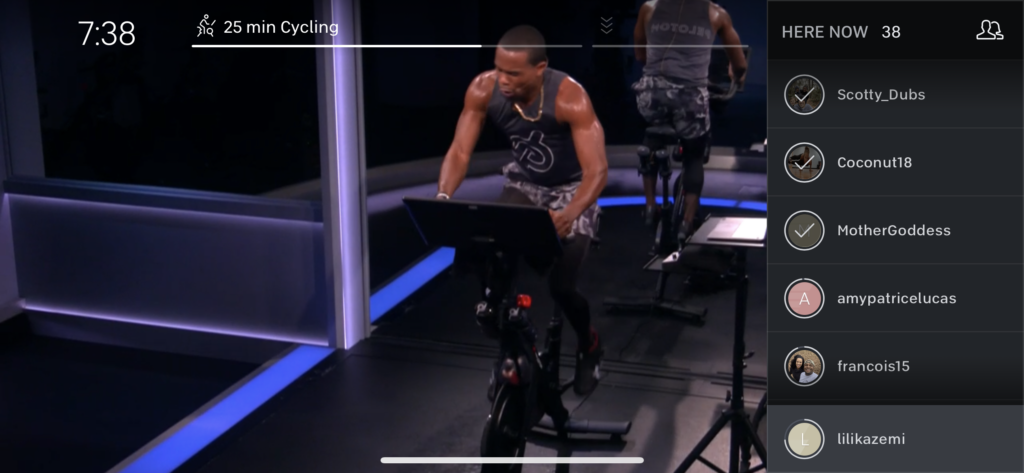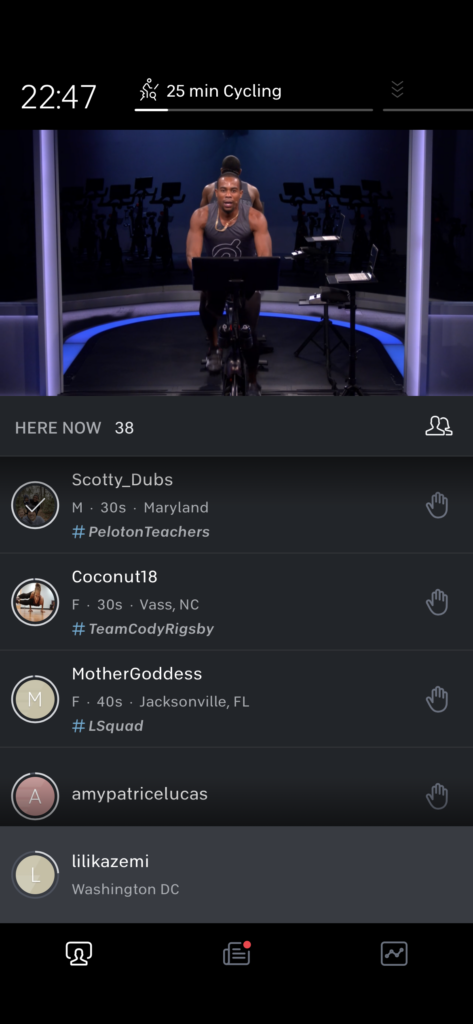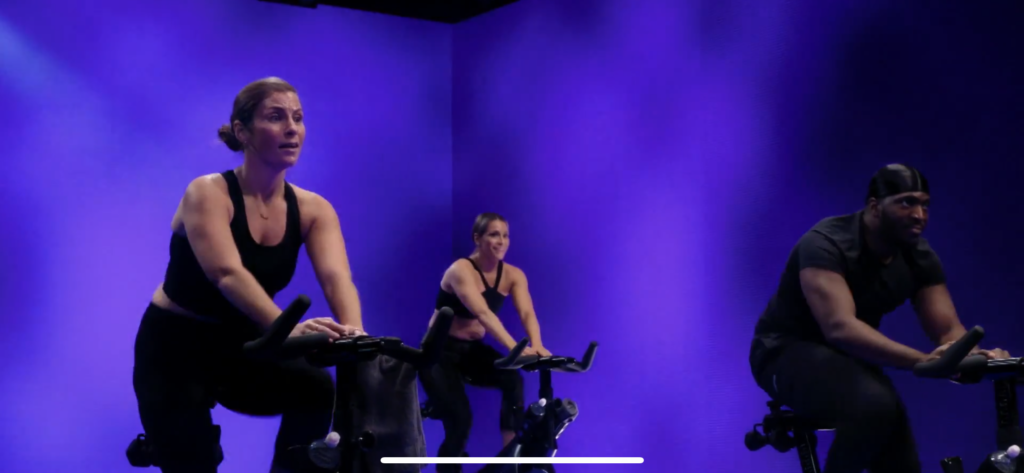Yeah, I am going there. I feel like I have a fiduciary duty to my corporate audience to do so. So here we go: how do we finally settle the battle of the at-home workout between Peloton and SoulCycle? As you will find out, it’s really about the Peloton v Equinox brands, as well.
Also, note that Peloton and SoulCycle are not the only games in town. NordicTrack, a long-standing brand, is getting into the game with its iFit bike and treadmills. For the iFit bike experience, there is also a studio class experience, as well as simulated scenery rides, like Tour de France. Haven’t had a chance to check this out yet, but it’s worth mentioning. For now, we will mainly focus on the two frontrunners.
What’s the Skinny?
- The Peloton has swept the nation as the ultimate at-home workout.
- Lately, the SoulCycle bike has also been making waves. Inevitably, the two are being compared.
- The choice of what is better for you really depends on what kind of workout personality you are, and whether you have a prior history with either brand.
- It is also a matter of whether you normally do a lot of other exercise activities besides cycling.
- Depending on the answer to these questions you may have a different result, with or without getting a bike.
In my industry when we do market research we focus on comparables. So when grouping apps for each discussion I identified the clear connection between Peloton and SoulCycle – they both have an at-home bike, and associated apps with a suite of other workouts. For Peloton, this would be the Peloton app. For SoulCycle, this would be the Equinox+ app (which until recently was known as Variis). Clarification: SoulCycle is owned by the Equinox brand.

Background on the Peloton and the app
Peloton is a phenomenal choice if you fit the right profile of workout personality type. In fact, Peloton probably wins for the most brilliant marketing and capitalizing on the pandemic, even after its stock-plummeting 2019 Christmas ad debacle (where the husband gives his thin wife a Peloton and she documents her horrifying journey).
After the onset of COVID-19 in the Western hemisphere just a few months later, this became no more than an archived YouTube video. Peloton has ARRIVED. #winning in this pandemic. It definitely helped that the bike had been selling since 2014, cementing its well-recognized brand as a go-to solution. There were also existing Peloton studios with their superstar instructors at their NYC studio.
I find it fascinating that I know so many people who bought and are practically married to their Peloton when they weren’t into spin before. It’s that powerful of a brand.
Why the Peloton is so hot right now
Peloton’s principal attraction is of course the bike, and the indoor spin classes with the celebrity status instructors. You can take the indoor spin classes live or on demand. Standard overachievers are drawn to the Peleton for the interactive competition and challenge you can experience from the convenience of your own home.
We can’t have this conversation without talking about theA-list instructors. Each of them has a following, some command exclusive loyalty. For example, Ben, a former accountant, attracts some of the 50+ year old partners at my firm, who will only attend his classes. I think the choice of instructor is highly dependent on your personality type and what you need for motivation. My favorite instructor is Alex Touissant. My friends tease that I of course would pick the drill sergeant. I like him for that and for his playlist, which you can access on Spotify.
A Type A exercise dream
If you are attached to quantitative metrics and seeing where you are in the “pack,” this is your wheelhouse (pun intended). You can see all of your stats – speed, intensity, heart rate – on the 22-inch screen during the entire ride. The “leaderboard” also displays your total output and where you rank among other riders. If you have ever taken a FlyWheel class, you get the basic idea. You can also get instant gratification from the instructor during live classes, where you can get “shout outs,” which is a usual occurrence for a “milestone” ride.
The cost factor
The Peloton bike itself is an investment – roughly $2,100-$3,000 (depending on what model and accessory package you buy, plus the additional subscription fee for the app (there is an available payment plan). The Peloton people clearly thought about this. On their site, you can calculate how much “savings” you would achieve by household with the Peloton bike or tread models you would buy. This of course, presumes you would relinquish a gym or any type of boutique type of studio at least for a period of time, which made total sense when the pandemic began. Now, as we are hopefully trending toward a return to normal life, that calculus could differ depending on where you live and how you would approach workouts without constraints.
Other non-bike classes in the app
The other classes range from treadmill workouts to yoga, HIIT, strength training, outdoor running, walking, and bootcamp style (incorporating the bike and the treadmill). The treadmill workout cannot be mentioned without the Peleton treadmill AKA the “Tread,” which is another potential investment of $2,500-$3,100 depending on what kind of gear you want.
Both treadmills and stationary bikes are machines people tend to have already in their homes, or would have access to at an apartment gym, for example. I would say that if you already have access to a treadmill, a separate Peleton treadmill isn’t really necessary to get the benefit of the intensity of the treadmill workouts, unless you are really into the metrics. The bike is a different story, though, it’s just not the same. The Peleton bike is inextricably intertwined to tied to the style of the classes.
Peloton offers cross-training, i.e., yoga, barre, HIIT, strength training, running, even meditation. Plus, you get a 90-day free trial of the app, even without the bike.
Positive aspects:
- The genius of the Peleton for the Type A audience that is as of now mostly homebound with no gym access is that the competitive, interactive quality intersects with astonishing convenience and a “no-brainer” solution to what workout is available.
- The nice aspect about many of the Peleton classes is that you can preview the playlist in advance.
- Peloton is more than a fitness solution, it is synonymous with a fitness lifestyle. The brand equity of Peloton is one of its greatest draws. The brand prides itself on an aura of exceptionalism and the notion of the “Peloton family”.
- As an example of the brand’s appeal, Peloton riding groups have formed all throughout office environments throughout the county. The ability to use Peloton as an interactive community to strengthen relationships with co-workers and meet other people has been of great value in a time in which humans are increasingly isolated due to the pandemic and long for inclusivity.
Drawbacks:
- The “shout outs” can get really distracting, especially because it’s done by username, which displays a lot of very odd choices. It is enough to have incited some discontented “rants” on Reddit (although, you can find a rant about anything on Reddit, to be fair!)
- If you are an avid yogi, weight lifter, or runner, the non-spin programs on this app run the risk of irritating you to death. The lack of specialized instructors in each area is really apparent, it’s basically a spin class on a mat. Also, the “shout outs” even show up in the yoga, which defeats the “zen” purpose.
- That energy and great playlists actually translate really well to the treadmill. I actually recommend Peleton for runners who like treadmill workouts in this post.
- The hyper focus on metrics and competition can detract from the cathartic and reflective experience of fitness. Some people who are not drawn to or empowered by competition could find the experience to be somewhat isolating.
Bottom line: If you are a Type A person who thrives on competition, interaction, metrics, and networking, Peloton is for you. If you want to mainly do the spin classes, and dabble in cross-training or yoga as a way to warm up, you probably are still good with Peleton. If you have been a longtime boutique class student or yogi, and you want to do these workouts at home, I would recommend considering other apps to supplement this need. Money-wise, an extra 40 bucks a month is a marginal incremental cost to the investment.
That leads me to the discussion of the SoulCycle bike and the Equinox + app.

Equinox+ AND THE SoulCycle Bike
The Equinox+ app is one of the apps that was launched specifically in response to the pandemic and targeted toward a specific audience, Equinox members. Being an Equinox member myself, I have had free access to this app since March. Starting in October of 2020, the app became available to non-Equinox members.
Right off the bat I noticed that there is an inverse logic of the appeal of the Equinox+ app to the Peloton experience. For Peloton, the non-bike workouts are ancillary, but for Equinox+, the massive library of Equinox-related brand workouts happens to include SoulCycle and optionally the bike. Therefore, I am going to review the app first, and then the bike and SoulCycle experience.
Non-SoulCycle aspects of the app
This part of the app clearly CRUSHES Peloton’s. It’s not even on the same level.
As part of the app experience, you get access to the Equinox suite of brands, including Rumble, TB12, Pure Yoga, and Headstrong Meditation, and the mainstream Equinox gym brand. Under each of these sub brands, there are constantly updated and cutting-edge classes (I will describe the offerings a little further below).
For those of you who aren’t familiar, Rumble is a boxing brand. However, many of the workouts are not only centered around boxing. There is a lot of HIIT, treadmill running training, and strength training.
TB12 is Tom Brady’s training program, which is not really about football but functional training focused on strength, balance, flexibility, and reducing inflammation. There are lot of workouts with bands and recovery/foam rolling oriented workouts. Anything related to Tom Brady, sign me up.
You can browse by category of workout, duration (including under 15 minutes, equipment needed (including bodyweight only), and body focus (upper body, lower body, abs, etc.) There are both on-demand classes you can add to your calendar schedule and and live classes you can schedule to attend in advance. Like Apple Fitness+, there is a “for you” section that has customized workouts based on your previous selections. (For example, it will say because you like X, we recommend these classes). There are also a bunch of headline workouts that are positioned as a highlight reel at the top of the screen.
Naturally the trainers for the app are actual Equinox trainers, so from the jump, there is a feeling of trust and credibility. The luxury brand feeling of the experience comes through, just like being in an Equinox gym. It is the closest you can get to an actual feeling on being in a workout studio. After each class, you can rate the instructor and provide feedback.
Programs
For the classes, there is a stunning variety and quantity – far more classes and class variety than the Peloton app. All of the classes are categorized under 7 associated brands, including the cult hit SoulCycle (we will get to that in a minute). So, unless you are familiar with Equinox, it could be a little intimidating, because there are so many categories and subcategories of each type of workout.
Running workouts
For runners, Equinox also has treadmill running classes available on their signature “Precision running” brand. This is essentially an interval training treadmill class based on alternating speed and incline intervals. There are also walking classes, and outdoor for both running and walking. For these classes, unlike Peloton, you only have a screen with your required speed and incline and a timer, as opposed to staring at an instructor for the duration of the class.
If you really like seeing an instructor, and more people in the video, there are more classes available under the “Rumble” (boxing) brand, which more closely resemble the Peloton treadmill classes with the instructor running on a treadmill. This morning, I took a HIIT running class with Kory Flores, which had cycles of springs for 15 minutes and then an ab circuit for 15 minutes. The Peloton app also has boot-camp style classes that combine various strength and core workouts with the tread.
What is different about the Equinox+ running workouts is that you can see participants is that the classes show the range of speed and incline you are supposed to be at in the bottom. For Precision Run, speed is based off of your PR (“personal record”), and the app asks you questions that help determine your PR.
Non-running workouts
The sky is the limit when it come to other types of available classes. I won’t attempt to list them all. As you browse, once you come across a class you want to try, you can add it to your schedule in the app so you will not lose track of it.
Yoga – vinyasa, power, restorative, slow flow, and classes that focuses on certain postures, like side crow or twists. There are also classes for certain time of day, like morning and before sleep wind-down yoga. There is even yoga to prepare for cycling and for after cycling. A yogi’s paradise, with specially trained yoga instructors.
Weight training and sculpting classes – this includes upper and lower body focused weight training classes, ab and core focused classes, metabolic conditioning (“Met Con”), push-pull, glute focused classes (e.g., their “best abs ever” class), slider-based classes, band-based classes, swedish ball based classes, and much more.
Cardio-based classes – There are different variations of HIIT, cardio sculpt, and Tabata, pre-cycling warm up classes, athletic conditioning classes, ladder-style classes (e.g., going through a series of movements and then back down like a ladder), animal flow, and dance.
Meditation: Another huge differentiator with Equinox+ is its access to Equinox Headstrong meditations, which has also been available to Equinox members through the Equinox apps. These are not just trainers dabbling in meditation but well-known mind experts like Dr. Michael Gervais, who leads many of the meditations. The meditations are also meticulously categorized by theme and goal, like body scan, focus on bigger picture, release, embrace the day. There is also pre and post yoga and cycling oriented meditations, meditations for starting the day and winding down to sleep, and meditations for stressful situations, like holiday travel. If you have a separate meditation app you are wedded to, this may not be what tips the scales, but it’s worth trying to mix it up.
Drawbacks:
- You can add any desired on-demand classes to your schedule, but I do not believe there is a way to schedule them at a certain time and link that to your google calendar.
- Unlike Peloton, you cannot view all the playlists in advance, or pre-download the workouts (if data or wi-fi are an issue).
- If you didn’t regularly go to SoulCycle or Equinox before the pandemic, you may not get the hype and be turned off by all the analysis paralysis. You have to have a general idea of what you are looking for and what particular focus you want for a workout. If you are at a regular Equinox gym, you only have a choice of an average of 10 classes a day. Here, you have hundreds of choices and more new classes keep popping up.
- It would be helpful if there was some kind of glossary for all of the classes up front for people who are not as familiar with the brands.
- Like with Peloton, some of the instructors especially on the live classes suffer from “try too hard syndrome”.
- If you are hooked on the shout outs, you are not going to get them here.
- There is a feature to schedule weekly programs where the workouts are all mapped out – which the Peloton app does not have. There is no flexibility to make substitutions, and the program only allows you three active days a week (whereas most people passionate about working out can be active 5-6 days a week).

The SoulCycle bike and on-demand classes
The main difference between SoulCycle and the Peloton is that SoulCycle has historically been more about the personal, live class experience. While Peloton has been selling their at-home bike since 2014, that is the same year when a wave of new SoulCycle studios started popping up around the counrty, especially the East Coast. For example, that year the first studio in Washington, DC opened, right around the corner from the Equinox in Washington, DC. I felt so lucky to call that my neighborhood. That also happened to be very close to the Georgetwon and George Washington University campuses. Studios also opened in other cities, like Philadelphia, and Boston.
There are 19 studios in its New York flagship as well as a good representation on the West Coast. At pre-pandemic time, SoulCycle had almost 100 locations in the U.S. Then COVID happened, of course turning everything on its head. Although some of the studios now have outdoor classes, the need to compete with the at-home bike and on-demand classes was paramount.
Naturally, as soon as the SoulCycle bike became available, the bikes and associated apps became direct market competitors. I found countless articles comparing the two, and have linked several for your consideration in the “more” section if you need more insights.
How the SoulCycle bike is similar to the Peloton
Like the Peloton, SoulCycle’s at-home bike experience includes both on-demand and a growing schedule of live classes. Class length ranges from 20, 30 and 45 minutes, and difficulty from beginner to advanced. Riders can filter by instructor, and preview at class playlists before committing to a ride (something never possible with the in-studio experience). If you like a particular song that is playing, you can even link and add it to your Spotify playlist. Like the main feature of the Equinox+ app, it also has a “for you” section with recommendations based on past class choices.
They have other aspects in common:
- About the same price – 2500 (includes delivery)
- Both require subscription to an app to use (Peloton app and Equinox+ app)
- Both apps can be used stand-alone without the bikes
- About the same size large touch screens
- Have “add on classes” you can do like arms or other strength training
How the Peloton and SoulCycle bike experiences are different
All the comparison reviews agree on one central concept: the difference between the two programs comes down to personal preference, including for the non-bike app features.
For experience, Peloton appeals to users who like competition, quantitative measurement, and just riding for speed or resistance. SoulCycle, on the other hand, does with its bike classes what it does with its real classes – strive to be an “experience,” often a spiritual journey. You can just tell by looking at the names of the classes – whereas, Peleton has stuff like Beyoncé theme ride (they actually have an exclusivve contract for her music), SoulCycle has classes like “Breakdown and Breakthrough”
As you can see from the picture of the SoulCycle app, SoulCycle classes attempt to simulate an actual class. You see people on bikes behind the instructors, and then you get views of the other members of the “pack” in the class. There are also features of the SoulCycle classes incorporated into the rides that you would not see in Peloton – “tap backs”, pushups, jumps, and a song. You also get the familiarity of riding with the well-known SoulCycle instructors, for example, Conor (NYC). SoulCycle seems to recognize the craving for metrics, and accordingly is introducing “Soulbeats” (which benchmarks your “connection to the music” and some other metrics). Nevertheless, Peloton is clearly the frontrunner in this space.
One other differentiator that SoulCycle has is the option to do a “Freestyle” ride. This is for people who just want to listen to their own music or watch Netflix, which is content built into the app.
What it all comes down to
I have done the best to give you an objective decision tree (although I may be slightly biased). For the bike, most of what matters is not what I see with my eyes, because I ride with my eyes closed (yeah, I am one of THOSE people). My loyalty as an devoted Equinox member and my familiarity with SoulCycle probably tips the scales in favor that way. That being said, it’s different strokes for different folks. Some of my friends are addicted to the Peloton, and after my own experience with their bike and their brand, I get it.
How to try before you buy
Each bike has a return policy, but there are other ways you can try each experience without having to bite that bullet. Peloton bikes are available at many mainstream hotels – even without the right shoes, you can just hop on and pick a class. For SoulCycle, I would say if you were a devoted Studio member that the app doesn’t stray that far. If you are not familiar with SoulCycle, some cities offer outdoor classes you can try for around 30 dollars a pop. Including in Washington, D.C. Once the weather stops being below freezing, I definitely will check it out and write up a review for you guys!
You should choose Peloton and Peloton app if:
- You are super competitive
- You like instant gratification
- You are a metrics person
- You are a networking queen
- You like Flywheel better than SoulCycle
You should choose Equinox+ and the SoulCycle app if
- If you are an Equinox member, it is kind of a no-brainer
- You are more about the feeling of being in an actual studio, with all the bells and whistles of the quality of studio, lights, and cinematography
- You are more about losing yourself in the music and riding with eyes closed than you are about grueling focus
- You have a Peloton but want more variety and better options for non-spin workouts, especially when travel picks back up again. Like I said, the Equinox+ app is hands down the best…so consider that you can’t exactly strap a 135 pound bike on your back).
More about the Peleton v Soulcylce bike experience
- Peloton v. SoulCycle at Home (medium)
- Can SoulCycle’s New At-Home Bike Compete With Peloton? (Bicycling Magazine)
- New York Times Peloton Review










